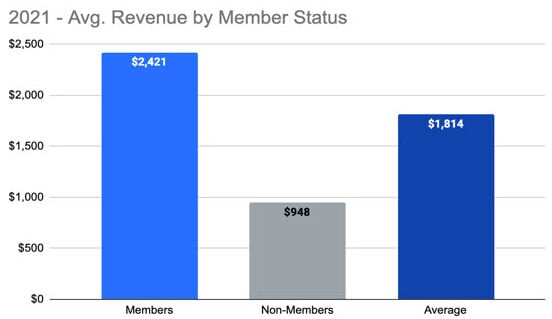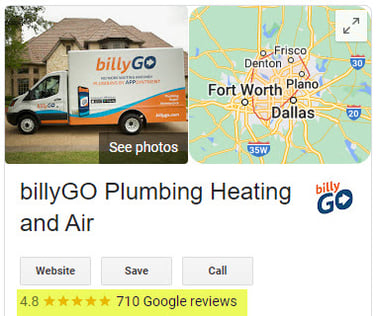Using Social Media for Small Business to Sell Maintenance Plans
Admin
Subscribe
Social media for small business didn’t take off like a rocket for most HVAC and other home service companies. In the early days of the 2000s, most small business owners didn’t spend a lot of time online. Many were skeptical of Facebook when it opened for business in 2004, and likewise with Twitter’s 2006 arrival.
If you’re one of the small business owners still not using social media to get more customers, you don’t know what you’re missing. If you are using social media but not getting the results you want, this article will help fix that.
Small businesses can use social media to help find new customers. HVAC, plumbing, electrical, and other home service businesses can use membership maintenance plans to help keep them and develop a sticky customer base happy to refer you to their friends.
Social media and maintenance plans are both about building lasting relationships, so they make a natural combination to get people talking about your company.
Fishing for Customers
Bass fishers don’t sit around and wait for something to bite. They keep looking until they find the fish. Then they use a variety of baits and methods of presentation to figure out what works best at that time in that place.
In the same way, social media for small businesses offers a variety of platforms and features to attract visitors to your website. You need to know which platforms or channels work best to attract new customers. In other words, what social media platforms are your customers already using?
We’ve done some basic research for you already. Here are the ones that tend to be most effective for HVAC and other field service businesses and the percentages of US adults that use them:
Youtube
Only local TV news comes close to the reach of YouTube and Facebook. However, TV news is passive, while social media is interactive. That interactivity opens the door for you to develop relationships with potential customers. Once you have their attention you can make them repeat customers and brand advocates through your maintenance plan.
Why Your Business Needs a Membership Maintenance Plan
Maintenance plans, also called membership plans, offer the fastest and simplest way to grow and expand a field service business, no matter the size or location. Like social media, membership plans help establish a relationship you can build on for repeat business and referrals year after year – which also reduces customer acquisition costs.
Just as some small business owners are not using social media, some don’t have a membership plan or have an ineffective plan. That is a lot easier to fix than you might think, if you use the right field service management software. Member management is one of the four pillar functions of Sera FSM software.
A robust membership management capability is built into Sera FSM software. Not only do you get more repeat business and referrals, you also earn more revenue per customer. This graph from one of our customers shows the money-making math of HVAV service membership plans:

The most certain way to sell membership plans is when your techs are face-to-face with customers in their homes or businesses. Showing customers detailed good-better-best proposals with non-member and discounted member pricing is very persuasive. The Tech App in Sera FSM software creates the proposals in three minutes or less.
For any small business, social media is a close second to being face-to-face with customers. For a field service business, think of it as having a tech in front of customers 24/7, 365.
The most certain way to sell membership plans is when your techs are face-to-face with customers in their homes or businesses. Showing customers detailed good-better-best proposals with non-member and discounted member pricing is very persuasive. The Tech App in Sera FSM software creates the proposals in three minutes or less.
What’s Holding You Back?
Many of us lack time and the skills to run our own social media programs. Another employee can do it, but you need to stay involved by setting goals, strategies, tactics, and metrics for all social media.
This seems to be a put-off for some field service business owners. We don’t like to talk about it, but we may have nagging doubts or even a fear of getting started. Here are five common reasons for delaying use of small business social media.
- Negative comments and ratings – People are using social media whether you do, or not. Sites such as Yelp, Google Business Profile, Facebook, Angi, the Better Business Bureau, ConsumerAffairs and Foursquare provide forums for praise as well as venting. Be involved in social media to build and protect your brand.
- Time commitment – Time devoted to social media is an investment, not an expense. That said, there’s no need to waste time when you can automate and manage all your social media accounts in one place by using tools such as SocialPilot, Sprout Social, Hootsuite, and others.
- Concern the ROI will not be worth the effort – Many of the tools used to automate social media also measure return on investment. You can track ROI by setting goals, having measurable objectives, and tracking results. A good goal is to bring in at least $3 in revenue for every $1 you invest in social media for a small business.
- Not comfortable with technology – Technology = change, and change = fear of the unknown. Change is quite literally a matter of business survival. Charles Darwin said it this way: “It is not the strongest of the species that survives, nor the most intelligent that survives. It is the one that is the most adaptable to change.”
- Privacy issues – These are best addressed by using strong passwords that contain at least eight characters that include upper- and lower-case letters, numbers, and symbols, such as #, !, and #. Change passwords every 90 days, using two-level authentication (text messages or email to cell phone with a one-time authentication code) and using each social media platform’s security measures.
 Here’s a good way to put social media for small business in perspective: Using social media is a little like walking down a street in your hometown, greeting people you know and introducing yourself to those you don’t know
Here’s a good way to put social media for small business in perspective: Using social media is a little like walking down a street in your hometown, greeting people you know and introducing yourself to those you don’t know
But there’s a huge difference: with social media, you can constantly “walk” down every street in every neighborhood in your service area. The more often people see your business name and interact with you, the more likely they are to do business with you.
Steps to Effective Social Media for Small Business
As with anything to do with your business, effective use of social media requires thoughtful planning and careful execution. A generation ago people studied how to get the best placement for their Yellow Pages ads because everybody used the Yellow Pages.
Not anymore. The old phone books were good for building brand awareness, but all a consumer could see was a print ad. In contrast, social media is interactive. Potential customers can see an ad or customer reviews, ask questions and get answers from you. You can include videos, photos, testimonials, and more to win them over.
With that in mind, there are some social media conventions any small business must observe. They’re not much different from those for any marketing medium.
1. Understand Your Target Audience
To appeal to potential customers, you must know something about them, what they need, and what motivates them. They’re not all alike. The needs and pain points of young families are different from retirees.
Conduct market research to gain insights regarding their preferences, demographics, and social media usage. Talk to customers, build email lists, and ask them how you can serve them better. Then show you are listening to them by providing information on social media about how you can help make their lives better.
2. Choose the Right Social Media Platforms
Use the same social media platforms your customers are using. As the list above shows, if you use only Facebook and YouTube you will reach about 70% of adults in the US. Facebook and Instagram are both part of Meta Platforms.
If you’re not already using social media, don’t try to do everything at once. Start with just Facebook and YouTube. Facebook users tend to be older than Instagram users. However, don’t think of Instagram being just for teens. People in their 20s, 30s, and 40s use it, too.
You also may want to include YouTube at the outset or add it later. It is a great place to store videos at no expense to you. You can get a lot of attention with a 30-60 second video that you post on Facebook and Instagram. Add other platforms if and when they meet a specific need.
3. Create Engaging and Relevant Content
Now we get to the heart of the matter – using small business social media to sell membership plans. The key is in presenting text, video, and photo content to tell people why they need to be a member of your plan. Include contests and give-away offers. Show photos and videos of your people on the job.
List all the positives about your maintenance membership plan and then outline what to say about each point. It might be things such as lower overall pricing for members, scheduling priority, covering all AC systems in the house, lower cost for annual tune-ups, and so on.
Make certain to hit on customer pain points, such as worry about unexpected breakdowns. Study up on the best times to release new content on different platforms.
For example, the best time to post on Facebook is weekdays between 9 a.m. and 3 p.m. The window is smaller for YouTube, with Tuesday, Wednesday, and Thursday between 11 a.m. and 2 p.m.
4. Use Influencer Marketing
Influencers are people who can help your business by mentioning and recommending it to others. They don’t have to be customers, but ideally, they would be. Most field service businesses are local, not national, so you must identify local leaders whose opinions matter.
You might partner with the founder of a community non-profit organization, for example, and post content on your Facebook page about it. The goals of social media for small business and non-for-profit organizations are nearly identical.
Not only will our content be available to your audience, but to the non-profit’s audience, as well. This type of post is clearly not sales-oriented, which will further your image as caring people who live and work in the community.
5. Use Small Business Social Media for Targeted Advertising
 Targeted advertising is what really sets social media apart from other advertising channels for small businesses. You can tell the social media platform who you want to see the ad, choosing from a variety of criteria.
Targeted advertising is what really sets social media apart from other advertising channels for small businesses. You can tell the social media platform who you want to see the ad, choosing from a variety of criteria.
With Facebook you can specify locations where people live and work, by county, city, and ZIP code. Demographic sorting includes age, sex, income, marital status, and more. Interests are another category, such as home improvement, health, or subscribers to certain publications.
Behavior is an especially useful category, such as targeting people who have recently visited your website, including for coupons and special offers. Closely related to behavior is engagement, including people who have recently commented on a Facebook post you made about new SEER2 ratings.
Partner connections can speed up the sales cycle, too. You may wish to create a Facebook ad about new HVAC systems to people who have applied for home improvement loans or to refinance.
Once you zero in on a specific audience, Facebook will optimize your ads for your audience. Test different ad formats, such as carousel ads, video ads, or lead generation campaigns, to identify the most effective approach.
6. Engage with Your Audience
 This is the most important step. All your other work is for nothing if you don’t interact with your audience. Use the 3:1 ratio of adds to non-commercial content, or even 4:1. When people comment on something you post, reply to them, whether their comments are praise or criticism – and do it promptly.
This is the most important step. All your other work is for nothing if you don’t interact with your audience. Use the 3:1 ratio of adds to non-commercial content, or even 4:1. When people comment on something you post, reply to them, whether their comments are praise or criticism – and do it promptly.
Use your social media automation software to monitor mentions of your company name across different platforms. Take a few minutes to set up some Google Alerts for your company name and words that are important to you. When they appear in Google search results anywhere, you will be notified by email.
Encourage satisfied customers to leave positive reviews and testimonials on social media sites, especially on your Google Business Profile. The Google reviews are displayed in Google search results as gold stars by your name.
7. Track and Analyze Performance
The real payoff of using social media in small businesses is in the data. To manage anything, you must be able to measure its performance. Measurement tools abound, and some come as part of the same software small businesses use to schedule and manage their social media posting and monitoring.
The social media apps themselves provide accurate, high-level data you can access for free, such as the data shown here about a Facebook post.

Hootsuite is a good tool to track performance across multiple social media applications. You can use it to schedule social media posts, and get data about clicks, comments, reach, engagement rate, impressions, shares, saves, and video views. You can correlate that with the membership management data in Sera to see the effect on membership sales.
With these tools you can track the effectiveness of an individual post or video and measure the overall effectiveness of a campaign. Learn what works and keep doing it. Don’t waste your time on content that doesn’t get results.
8. Maintain Consistent Effort and the Right Balance
As with any type of marketing, social media requires a consistent effort over a period of months and years – months to get started, years to make an impact. People need to see a brand name 5-7 times before they become aware of it, and many more times, consistently, over months and years before it is familiar enough for them to recognize it and remember the name.
Also, no one will see every post you make on social media. For a person to see your name 5-7 times may require 25-35 posts on a social media platform. It takes time to get enough content posted on the application to move the needle.
You can’t do it all at once, but you can shorten the time required to build your brand by including paid advertising, as discussed above. Paid and organic posts complement each other. A good mix of 3-4 organic posts for every paid post will show people you are there to inform, as well as to sell.
Important Considerations
- Establish a regular cadence, or frequency, for adding content and stick with it. This will vary depending on who will manage the social media accounts and their ability to write copy, create visuals, and select the best times to add content.
- Post content on a variety of topics related to your business and link it to additional information on your website, such as blog posts, news releases, videos, new products and services, announcements, holiday and emergency information.
- Use a conversational tone that encourages people to comment and share your posts with their friends.
If you do these things you will have success with social media in any type of small business. At Sera, we do them with our own social media accounts. As a result, our followers and subscribers have increased from 107% – 183% across all platforms. By including videos, the number of our YouTube subscribers increased more than 700% in nine months!
Conclusion
Social media for small business is one of the most powerful marketing channels any HVAC, plumbing, electrical, or other field service business can use. If you aren’t using social media, you are needlessly giving your competitors a competitive business advantage.
Social media and membership maintenance plans are both about building long-term relationships with customers who will do repeat business and gladly refer you to their friends. This not only reduces customer acquisition costs, it boosts revenue: members spend 2.5 times more than non-members.
Some small business owners put off getting involved with social media because of concerns about the time commitment, return on investment, privacy issues, needing to learn new technologies, or having to deal with negative comments. There are proven ways to overcome all of these.
The best way to establish and maintain a productive social media presence for any small business is a planned approach that includes:
- Understanding your audience
- Choosing the right social media platforms
- Creating engaging and relevant content
- Using influencer marketing
- Using social media for targeted advertising
- Engaging with your audience
- Tracking and analyzing performance
See how Sera will help grow your membership plan and get you more business.
CLICK HERE

